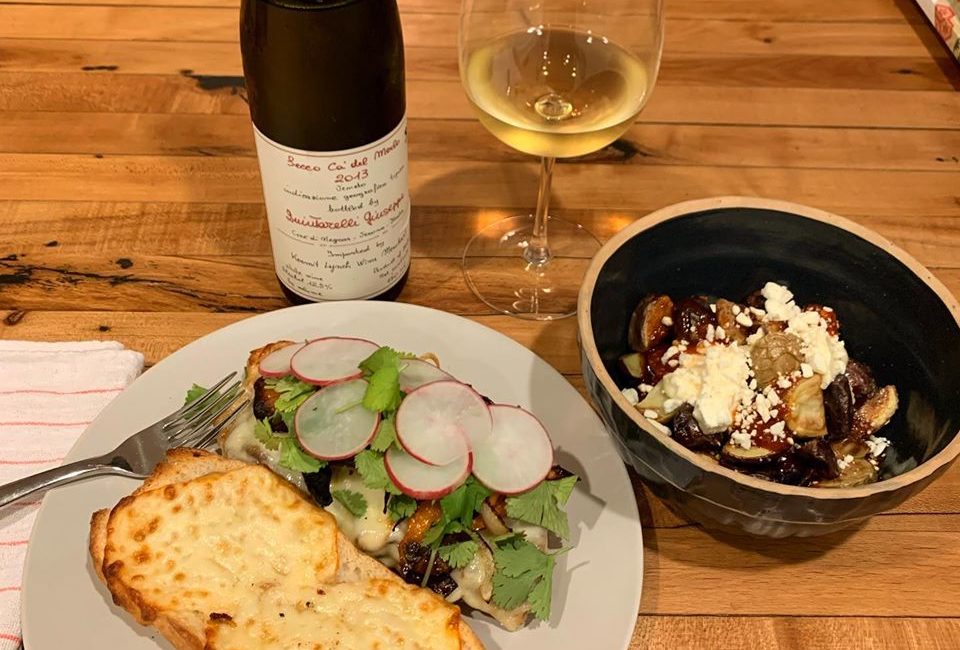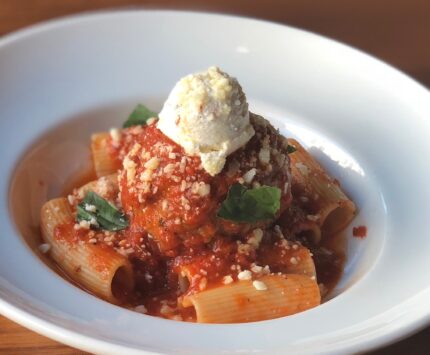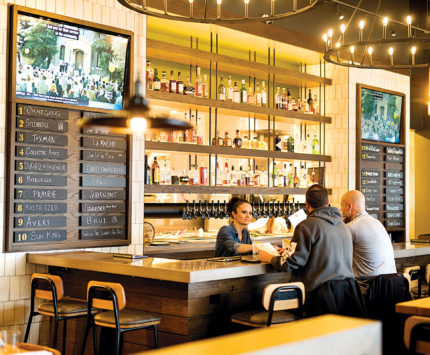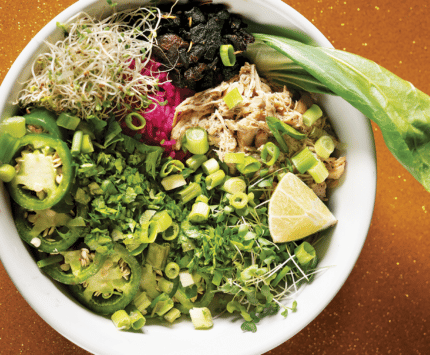What’s On The Minds (And Plates) Of Indy Chefs

Short Rib Bö Saam Cheesesteak with Potatoes, mayonnaise, sambal, and Saam sauce. Image courtesy Neal Brown
Chef Neal Brown has been craving simplicity lately. Cheesesteaks, pasta dinners, meat and potatoes. That’s if you can call his cheesesteak “simple.” You may be firing up your stove a lot more these days as you’ve been sheltering in place, getting back to basics, using some of the groceries you stockpiled as public officials hoping to stem the spread of the coronavirus pandemic gave us the stern advice: stay home. But the owner of The Libertine and Ukiyo, which he closed last Wednesday after a week of offering carryout supper dishes and pantry staples, isn’t exactly opening a can of Cheez Whiz. Brown piled his “quarantine trash” cheesesteak with leftover short-rib bö saam, a Korean delicacy, and served it alongside potatoes slathered with mayonnaise, sambal, and saam sauce.
However, these cravings aren’t just the whims of a chef at play with a few weeks off. “I’ve been talking to a lot of chef friends about what they’re cooking at home,” he says. “They’re making many of their old dishes. Baking bread. I’m planning to make chicken and dumplings this weekend.” It’s no secret that chefs, many of whom have had to tell their line cooks and wait staff to go home, with no certainty that their jobs will be there in a month’s time, are facing some of the worst stress of the current health and subsequent financial crisis. “I think we’re all unsettled,” Brown says. “Uneasy. So we seek out comfort the only way we know.”
Chef Thom England, Culinary Program Coordinator at Ivy Tech Community College, puts it in starker terms. “I’m really worried about what this could do for so many people living day to day from tips,” he says. “Several students have dropped their classes to get the refund. There will be a big scramble of workers to take the jobs as they open. Many restaurant workers will go elsewhere. Even with government help, we will lose many small businesses.” This is a blunt forecast for a restaurant community that, over the last decade, has just been getting its feet under itself, and proving its muster on the national scene. Many local diners are worried that, when we come out of this crisis, their favorite restaurants won’t be there to serve them dinner.

Fischer Farms steaks from Studio C Indy’s carry-out grocery with the new Ruth’s Stash Hazy IPA from Scarlet Lane Brew SoBro for dinner.
That hope that they will survive to feed their regulars is what’s fueling some restaurants to stay open against all odds, changing from creative, full-service establishments to something more like the neighborhood grocery of old. Bodegas serving sandwiches and soup. More subsistence than cutting-edge cuisine. For those culinary soldiers, the stress is real, and the positions they see themselves in are like none they had imagined. Often, they’re left to guess at how to best safeguard their kitchens without consistent guidance from health department officials who have too much else on their hands. They take credit card numbers over the phone, allow only two or three customers into the building at a time, leave carryout in bags on the curb. And they clean and clean.
“We clean like maniacs,” says Erin Kem, chef at Cannon Ball Gastropub and other Scarlet Lane tap houses in Broad Ripple and Beech Grove. To meet the demand for a comfort food that’s not usually on her creative, seasonal menu, she cooked up more than 20 pounds of raw macaroni last Friday. Instead of her rotating menu of bar snacks, beer floats, and North African and Central European–inspired specials, she was offering a $40 grab-and-go “Ozarks and Chill” package where customers could get a growler refill, a fully dressed pulled-pork dinner, and brownies to take home to the safety of their houses and their Netflix accounts. Bulk production like this wasn’t exactly in Kem’s plan until now, though she’s also planning to provide more sensible meals for two.
“We’ve got a fantastic, creative, and innovative team [at Scarlet Lane],” she says, “but the new normal is that we have a conference call every week to strategize what’s selling, what do we need to do different, what things do we have to change to deal with the day-to-day.” This has all come with a gradual reduction of staff. “One of our best bartenders bowed out for his own safety,” Kem says, “and two employees self-quarantined.” What is Kem’s hope for the other side of the crisis? “I’m hopeful that when things go back to normal, people are going to flock to places. We’re too social just for dining at home.”
Another local chef who has been using the time off to experiment and take things slow is Alan Sternberg, formerly of Cerulean and Field Brewing, and currently working with Brown at Ukiyo. Like many home cooks, he’s been baking bread, including gorgeous loaves of cast-iron focaccia he has posted to Facebook and Instagram. “We’re cooking everything right now. I’m taking the time to play with some longer-prep items that my schedule doesn’t usually allow (like sourdoughs). I’m also taking the time to cook things I really love, which is a lot of pasta.” His striped bee-pollen ravioli now has its own YouTube video in the series I Heart Pasta, which he produces with his wife, Audra. For Sternberg, he takes a more mixed stance on the current health crisis and its impact on the restaurant industry. “I think as chefs, it’s easy to get wrapped up in the grind of a restaurant, and you don’t get to enjoy the meals with your family as often as you should. As far as the industry goes, I’m worried. I don’t know how we come out of this kind of break in a good way. The margins are too thin, and the people that actually make up restaurants are dependent on payday. I’m hopeful we can get through it all, but I’d be lying if I said that with confidence.”
What advice do these chefs give to home cooks right now trying to orient themselves to their kitchens? Sternberg says that it’s a time to think about cooking projects and slightly more time-consuming recipes that will help you in other ways. In addition to pasta and bread, he’s making bone broth and pickles, somewhat lost arts in the era of big-box supermarkets. But he suggests that home chefs learn how to stock their kitchens more efficiently. “The better your pantry is, the easier it is to cook at home.”
Kem has noticed a trend at local grocery stores and even restaurant supply houses. Whereas the shelves of canned goods, processed items, and toilet paper are bare, there is still plenty of great produce available at local markets. “People are feeding themselves processed comfort,” she says, “when the very stuff of good cooking is being left behind. I can find just about whatever I want at stores these days.” What is she cooking at home to destress? “We’ve found ourselves walking to more places in the neighborhood and discovering great local products. We have a hilarious stockpile of canned vegetables and soups that we thought we needed to buy. But we picked up a great Fischer Farms flatiron steak at Greg Hardesty’s Studio C, as well as his great hummus and curry-almond dip. We ate the leftovers with a steak salad and soup the next meal. I guess this is how most people cook.” Her takeaway: Piece a meal together from the best local ingredients and prepared items, the way people in other countries shop at open-air markets every day.
“I think we’ll see a spike in culinary schools again,” England says. “I see lots of people taking more interest in cooking while they’re home right now. Everyone is posting food they’ve made. Those who do get takeout are dressing it up on china and eating it on Zoom with their friends.” Brown, who posted a startling graph from Restaurant Business Online that showed a near 100 percent drop in OpenTable reservations since the beginning of March, opined that many chefs returned to Indy over the last decade and started a back-to-basics comfort food scene that fueled the flowering of Indy’s restaurant boom. He predicts a period of “deep introspection” from chefs, which typically follows crises, such as the recession of 2008. But from trouble often comes a new vision. “Everything is cyclical in food, as in most things, and this crisis will hopefully poise us for America’s greatest food revelation yet: embracing a cuisine of our own.”





